Some car models have a reputation for blowing their gaskets. Checking for blown gaskets can be a challenge even for the most experienced mechanic. For you to know whether your gasket is blown, you need to know what and where it is.
The head gasket is located between your cylinder head and engine block. Depending on the model of the car, the engine block varies in the thickness and how it was constructed. The gasket is essential because it closes off the combustion chamber, which allows your car to maintain the efficiency of the engine by containing the exhaust gases and builds the proper compression. It also prevents oil and coolant away from the combustion chamber.
Different things can point to a blown gasket. These are:
- Overheating engine
The most common sign of a blown gasket is an overheating engine, especially after log drives. The engine consumes the coolant, and the radiator is unable to cool the contaminated coolant. When the engine overheats, it can cause several problems. It can damage the engine seals and gaskets, leading to costly repairs.
- White milky oil
When coolant leaks into the combustion chamber, it finds its way to the oil. After a while, the water and oil will mix to form a white, milky oil substance. When water mixes with oil, it affects the ability to lubricate the cylinders and other parts. This mixture will lead to accelerated wear and tear of your engine parts. You can check the oil color through the dipstick and the oil cap.
- White smoke
With a blown gasket, coolant leaks to the combustion chamber, and this affects the exhaust color. You will see white smoke rising out of the exhaust if the head gasket is blown. The smoke will have a sweet smell.
- Radiator bubbles
When coolant leaks to the combustion chamber, it can cause bubbles to appear in the radiator, making it seem like it is boiling. The bubbles come from the exhaust chamber when the gases force themselves into the cooling system.
- External leaks
When the coolant can be seen leaking to the outside, it shows that there is a head gasket leak. If it comes from under the exhaust or intake manifold when the engine is warm, it might be a leak. If there are other cooling passages, you may need to add a UV dye and watch the head gaskets with a UV light so you can identify the leak.
- Cooling system malfunction
Another sure sign of a blown gasket is a malfunctioning cooling system. Other things can lead to a malfunctioning gasket. You can perform a leak down test to confirm if the head gasket is blown.
If you observe any or more than one of the symptoms, you need to avoid driving your car as much as possible. The mixture of hot gases and coolant leads to damage to other engine parts. This can leave you with costly repairs. If you suspect your gasket has a problem, you need to contact your mechanic so they can diagnose and fix it before it gets worse.





 Who We Are
Who We Are Coverage Area
Coverage Area Donate
Donate